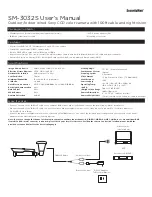
889-2106-03
Model U-1400 Operations Manual Rev Apr 2020 Page
8
of 39
I
NPUT
/
O
UTPUT
I
NDICATORS
: The detector has three dual color (green / red) LEDs to indicate the following:
VITAL IN LED Status
Meaning
OFF
Vital Input is deactivated (low voltage level).
ON (GREEN)
Vital Input is activated (high voltage level).
ON (RED)
Vital Input has failed its self-check (Vital Input, Primary Vital
Output, and Auxiliary Vital Output revert to OFF state).
VITAL OUT LED Status
Meaning
OFF
Primary Vital Output is deactivated (low voltage level).
ON (GREEN)
Primary Vital Output is activated (high voltage level).
2Hz FLASHING (GREEN)
Timing Delay activated and Primary Vital Output is working
(high voltage level until delay times out).
5Hz FLASHING (GREEN)
Timing Extension activated and Primary Vital Output is
working (low voltage level until extension times out).
ON (RED)
Primary Vital Output has failed its self-check (Vital Input,
Primary Vital Output, and Auxiliary Vital Output revert to OFF
state).
VITAL AUX LED Status
Meaning
OFF
Auxiliary Vital Output is deactivated (low voltage level).
ON (GREEN)
Auxiliary Vital Output is activated (high voltage level).
ON (RED)
Auxiliary Vital Output has failed its self-check (Vital Input,
Primary Vital Output, and Auxiliary Vital Output revert to OFF
state).
R
ESPONSE
T
IME
: See Section 3.4 for response times.
S
ELF
-T
UNING
: Each loop circuit tunes and is operational within two seconds after application of power or after
being reset. Full sensitivity and hold time require 30 seconds of operation.
E
NVIRONMENTAL
&
T
RACKING
: The detector is fully self-compensating for environmental changes and loop drift
over the full temperature range and the entire loop inductance range.
G
ROUNDED
L
OOP
O
PERATION
: The loop isolation transformer allows operation with poor quality loops (which may
include one short to ground at a single point).
L
OOP
(F
AIL
)
M
ONITOR
: If the total inductance of a channel’s loop input network goes out of the range specified for
the detector, or rapidly changes by more than ±25%, and the Loop and/or Health status outputs are mapped, the
Loop and/or Health status outputs will immediately enter Fail-Safe mode and the LCD will display
LOOP FAIL
.
The type of loop failure will also be displayed as
L lo
(for -25% change or shorted loop conditions) or
L hi
(for
+25% change or open loop conditions). This will continue as long as the loop fault exists. At the time of a loop
failure, the Loop status LED will begin to flash at a rate of three flashes per second. The LED will continue this
display pattern until the loop input channel is manually reset or power is removed. If the loop self-heals, the
LOOP FAIL
message on the LCD will extinguish and the loop input channel will resume operation in a normal
manner; except the Loop status LED will continue the three flashes per second display pattern, thus providing an
alert that a prior Loop Fail condition has occurred. Each loop failure for the loop input channel is counted and
accumulated into the Loop Fail Memory. The total number of loop failures written into the Loop Fail Memory
(since the last power interruption or manual reset) can be seen by stepping through the loop input channel’s
detector functions in Program Mode to the
LOOP FAIL
message. When the status of one or more loops is
assigned to a Vital Output, a loop failure will deactivate the Vital Output and the corresponding
VITAL OUT
LED will turn from green to OFF to indicate the failure. When a Health Status is assigned to an Auxiliary Vital
Output, a loop failure will deactivate the Auxiliary Vital Output and the corresponding
VITAL AUX
LED will
turn off.
L
OOP
C
HECK
: This feature is used as a means of verifying proper operation of each inductive loop connected to a
detector. In a typical installation, a separate loop of wire called a check loop will be wound around the perimeter
of each inductive loop. The Loop Check Timer can be programmed with a value ranging from 1 to 255 minutes.
Once this time interval has elapsed, the detector will automatically short the check loop simulating vehicle
detection in the inductive loop. If this initial loop check test fails, the detector will enter a verification mode to
make certain that the loop failure is indeed due to a loop related problem. While operating in this verification
mode, the detector will perform a series of ten verification tests and the LCD will flash
Pcl
. If the ten loop check
verification tests all fail, the Vital Output(s) to which the Loop Status Input(s) and/or Health Status Input(s) is (are)
mapped will be deactivated. The loop check test will be repeated at regular intervals depending on the value
programmed into the Loop Check Timer. The Vital Output(s) to which the Loop Status Input(s) and/or Health
Status Input(s) is (are) mapped will not be activated until the problem with the check loop is corrected and the
















































